
Tom Phillips
When you meet someone you haven't encountered for sixty years you shouldn't be surprised to find them changed utterly. So it is in my case with Tully, as Marcus Tullius Cicero was always referred to by our classics master. I well remember the long feared exposure of my shaky grasp of Latin when singled out to stand up in class to read out and translate a tortuous paragraph from the Orations.
Almost a caricature of pedagogic dryness this teacher never once hinted at Virgil's epic swagger or let on that Horace was a cunning and sexy satirist. They were there, it seemed, to show that Latin was horrible and hard; with Tully the toughest of the bunch.
Horace and Virgil yielded to later reading but the idea of revisiting Cicero was like being summoned once more to stand outside the headmaster's door, awaiting reprimand or punishment.
The opposite, as Cicero himself might have said, would prove to be the case. Having riskily agreed to accompany some of the Orations with pictures (illustrations doesn't somehow seem to be the right word) I plunged anew into the once detested text.
I was amazed to find that today was two thousand years old. Same cast, same evils. The knuckle-rapping invective sometimes read like a rediscovered Pompeian copy of Private Eye: only the barmy army of religionists was missing. All the crime, corruption and political skulduggery of the age of Bush and Blair was well matched. In the Rome of today, the outrageous Silvio Berlusconi whose lifestyle and morality as a statesman were pre-echoed blemish for blemish in the Philippics against Mark Anthony.
Dissatisfied with the translations that I looked at I found my dim Latin was just enough to illuminate the wit and invention of the prose and to recognise all those verbal strategies of orators I have heard in my lifetime, from Churchill to Obama.
I took the most famous tag of all, O Tempora O Mores, as a kind of leitmotiv... the best translation (if one adds an exclamation mark) being Trollope's title The Way We Live Now. This I made into a mosaic, variously interfered with to produce O Amores, O Mores etc. Making guest appearances in the book, in addition to Berlusconi, are Fidel Castro, Mick Jagger, Catullus, Christine Keeler, Julius Caesar, Dante's Beatrice, Agatha Christie, The Elgin Marbles, Vincenza Foppa, Mussolini and a London smuggler of antiquities who shall remain anonymous.
Cicero: Orations is soon to be published by the Folio Society. Copies may be purchased in their online shop http://www.foliosociety.com/
Ornament, pencil 2011, 30cm diameter
Long ago I teamed myself up with Jessica Rawson to prepare an exhibition at the Royal Academy that would define and celebrate Ornament. We made a trip to the vaults of the Vatican to start the hunt for likely exhibits, and travelled to Vienna to continue the search. It was there over supper at the Sacher Hotel that we discussed in earnest what the show would say and what it might contain.
We questioned each other's choices of the previous days. It soon emerged that our concepts of ornament, its nature, status and role in art were quite different; in effect irreconcilably opposed. With tempers frayed we retired to our respective rooms.
I intended, before finally turning in, to jot down a few clarifying notes, but eventually sat up half the night composing a manifesto that I could read out to Jessica (and to Simonetta Fraquelli who was with us) over breakfast. I only half realised that this would mark the end of the collaboration and the evaporation of the project as a whole. It was this polemical pamphlet that some months later I presented at the RA's Architecture Forum.
Ornament frequently creeps into what I do, usually by way of borders and framing devices. That it was on my mind at the time can be seen in the drawings that obliterate the many agendas and minutes of Merry Meetings (D3 Editions 2005) including its cover illustration.
On my return from Vienna, remembering Derrida's contention that the margins are at the centre, I set about an ambitious exercise in pure ornamental mode. I soon got lost in its improvised and unsystematic convolutions and set it aside as unsolvable. My artistic performance had not matched my rhetoric.
I have now retired from the business of formal portrait painting and stepped down from committees. Taking advantage of new resultant gaps of time I could return to the drawing abandoned so many months ago. Unravelling and reravelling I managed at last to bring it off.
Duino Ornament, h42cm x w29cm, 2011
I made a smaller coloured version, making minor adjustments to balance the field of energy. To this I added, as if to challenge the ornament's autonomy, the opening words from Rilke's first Duino Elegy which kept running through my mind; with various translations forming and reforming as I worked. Not a title but an accompaniment. Wer, wenn ich schriee, hörte mich denn aus der Engel / Ordnungen? Perhaps this could be the official badge of the order of angels.
The transfer of my archive to the Bodleian Library might have felt like parcelling up one foot and posting it direct to the grave. But it has not been like that at all: the opposite in fact, for out of that arrangement has come new life for a long cherished project.
For twenty years I have been collecting real photo postcards of anonymous people. They all date from that period when portraiture suddenly became democratised. At the beginning of the twentieth century all manner of people, not just the wealthy, could for the first time in history possess their likenesses. What resulted was an inadvertent and unofficial visual census of the country.
Out of over a million of such cards that have passed though my hands I have brought together fifty thousand or so which now, in albums and boxes, crowd out what passes for my kitchen. They are grouped under titles that announce the obsessive typologist, Two Men, Tree, Pram, Bather, Nurse etc.
I exhibited a selection of these cards in 2004 at the National Portrait Gallery in a show whose catalogue, We Are The People should now be seen as a trailer to this current series of books published by the Bodleian itself. Readers was the natural first title in what promises to be an extensive but not expensive sequence produced by one of the world's great libraries.
Issued at the same time was Women & Hats. Weddings and Bicycles appeared soon after with the same generic rubric Vintage People on Photo Postcards. All four are now available and more are to follow. Watch this space: start clearing a shelf
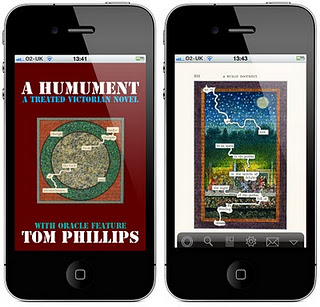
To celebrate the appearance of A Humument App on iPhone I shall shortly add a dozen or so newly revised pages. The first to change will be page 1 (which is what one sees on opening the app) in its original version done in 1967 not long after textual intercourse, for me, began. The standard introductory phrase of a would-be epic, the Virgilian/Miltonic I Sing has to remain of course. What most cried out for change was the somewhat tentative surround. Here it is in its new livery as trailer for adaptations to come. (Click image for detailed view.)
The strangest eaffect of my possession of an iPad (I do not have an iPhone) is that I have become my own consumer. Each night after midnight when the daily page first announces itself I consult, somewhat furtively (even though alone), the Oracle that I have made. I am often surprised by pages made long ago and almost forgotten, as well as by the sometimes uncanny predictions they offer their maker.
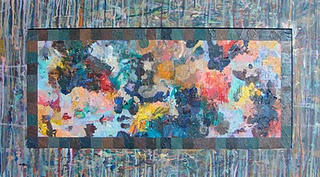
The Remains of the Day, 2011, recycled acrylic palettes on board, h41 x w76.5cm
It's all Daphne's fault. Meeting my friend the admirable portrait painter Daphne Todd at Green & Stones in the King's Road (the last true artist's shop in London) I saw that she had bought a pad of disposable palettes. She said she always used them... so practical, no more cleaning palettes at the end of a working session etc. I said I thought they were meant for amateurs but I would give them a go; and anyway I had just used up my three wooden palettes making Beckett Again and had been about to buy a new one.
So, for the whole of the reworking of Quantum Poetics I used them for mixing colours and for making the cumulative mix for the current Terminal Grey canvas. Always aiming to be the Compleat Recycler I did not however dispose of them but let them pile up and dry in the corner of the studio.
Nor did I discard the sturdy tray that Andy had made to house the panels of Quantum Poetics as I was painting them, and on which I cleaned my brushes as I proceeded.
One day looking at these curling, flimsy but paint laden palettes I had a taste of that epiphany that visited Kandinsky a hundred years ago when he observed that the mixtures and random conjunctions of colours on his palette were perhaps more exciting than the picture he was painting.
I could see that the verve of the brushwork and the sliding and colliding (often called 'painterly') of colours were events that had largely eluded me in my work, as was the physical presence of paint itself that French artists call matière.
How to harness this observed energy was the problem. Boulez (quoting Sibelius) says that, to compose, 'one must take delirium and organise it'.
I got Andy to make a single panel that would exactly fit his tray frame (now itself covered in streaks of paint, plus the odd brushed-in memo or telephone number). I made a border for the panel of square sections of Terminal Greys gathered from the palettes, to link it with my original recycling project started over forty years ago. This made a frame within the frame. Then I started to build an improvisatory mosaic of choice fragments of colour and texture, following where the emerging shapes led, sticking down the little rectangles piece by piece with acrylic medium. Scissors, scalpel, straight-edge and glue brush was all the equipment I needed, and, once stuck down the pieces remained with no revision allowed.
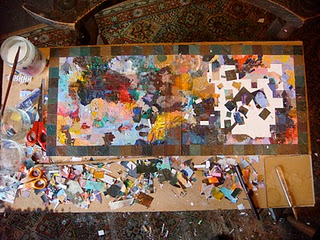
I call the picture The Remains of the Day, a recycled title from Ishiguro's novel which would appear to be in turn a recycling of Sigmund Freud's Rückstände des Tages, the daily residue of impressions that make the basic recipe for a later encoded dream.
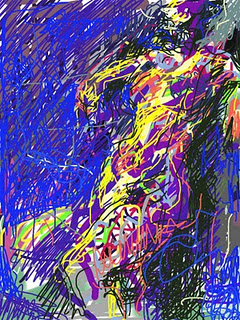
Having downloaded the Brushes app on my iPad I was keen to try it out. An evening at the venerable London Sketch Club armed with no other drawing tools put me nicely on the spot.
With half hour poses being the order of the day I had four chances to make a fool of myself (since being so oddly equipped made me an object of curiosity). Luckily I could quickly press the bin ikon and trash my first three attempts which went sadly out of control. By the last pose I was almost getting the hang of it and produced something like a drawing I could honourably leave on the screen. So I count this my first effort. Certainly in terms of new technology it is a Sketch Club First, though essentially it seemed old fashioned as I held my reminder of a child's tablet to work on. Drawing with my finger, moreover, seemed virtually prehistoric.
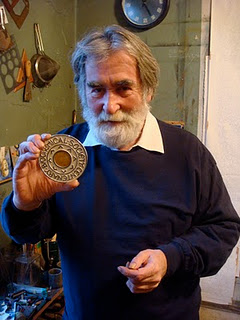
See what you get if you practise, as Liberace used to say, pausing at the keyboard to flash his huge diamond ring at children gathered round the stage.
This is the Biochemical Society's highest honour made to celebrate its hundredth anniversary and much as I would like it to be mine as a result of spectacular research in Biochemistry I am here showing it off merely as designer.
It was Martin Kemp who suggested my name to the Society and Sheila Alink-Brunsdon who saw it through the usual controversies.
As soon as I spotted a translucent cabuchon of fossilised coral at a mineralogical shop in New York I felt that this would make a marvellous insert to enliven a medal that was more the size of a coaster than a coin. My thought was that this living organism had been transformed through long chemistry into its mirroring self in mineral form. The Very Intelligent Designer had scored once again in reflecting a structural complex that could be cosmic, miscroscopic, cellular or stellar in scale. It has become one of the endless pleasures of looking at pictures in Scientific American to guess whether they are of some event in space or some tiny happening in the world of the infinitely small, so similar do they seem in their patternings.
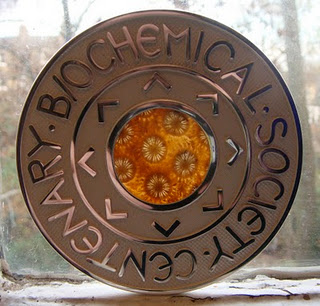
The hardest part of the operation was getting flat discs of the fossil coral which eventually came from far off in Surinam, via Tucson to the ever helpful Ammonite 2000 Ltd. in Pimlico Road. This took a long time to arrange but since the coral had been some millions of years in the making a few more weeks did not seem to matter much. Only 2mm thick they admit the light that reveals their delicate structure when the medal is held up.
The medal is otherwise made of pure Brittania silver which has a lovely weight and feel, and the whole was expertly manufactured by Fattorini.
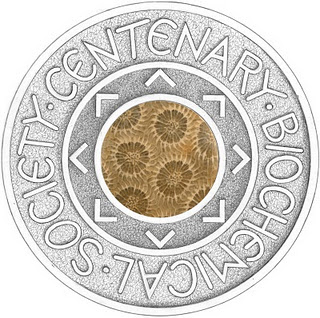
Design for Biochemical Society Medal, 2009, Pencil drawing.

On returning from Princeton the big excitement at Peckham HQ is presiding over the final birth throes of my Humument app for iPad which is now up and running thanks to midwives Lucy and Alice, consultant Jonathan Hills and the surgical expertise of John Bowring.
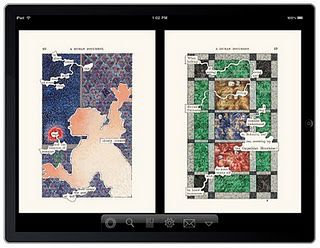
So, safely delivered it shows, in colours more glowing that my pens and paints could achieve, almost like church windows at times, the whole of A Humument, including very recent pages. And all at full size, together with a device for using the book as an oracle in the manner of the randomised predictions of the I Ching (though on the iPad a little internal jiggery-pokery replaces the never quite available yarrow sticks).
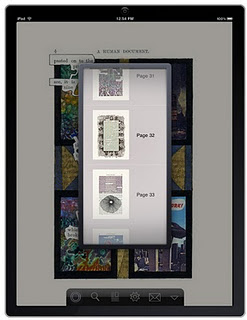
Very soon after starting the book in the sixties I dreamed of its use as an oracle and it has taken forty years for technology to make that possible.
So if you have an iPad you should go straight to A Humument in the app store and have a look. If you do not have an iPad a word to Father Christmas might do the trick. If you only have an iPhone, well stick around: there will be a miniature version early next year.
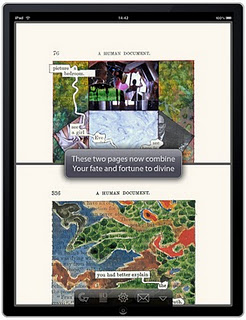
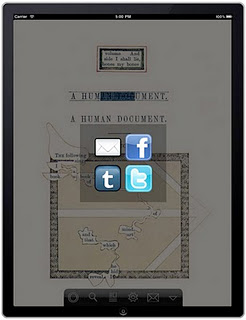
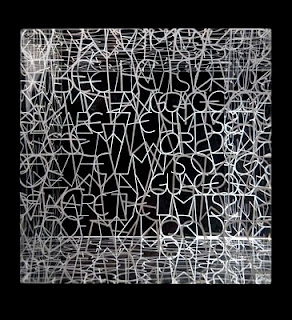
Wittgenstein's Dilemma, 1999, silkscreen on acrylic cube. Photo Ben Drury.
Back once again on Einstein Drive after an enjoyable opening at Flowers, my first in their splendid new gallery on W20th. The usual loyal and loved suspects turned up i.e. Ruth and Marvin Sackner (with their brilliant grandson), John Pull (bravely after illness) and Richard Minsky, who brought with him one of my heroes, the 94 year old George Braziller, whose book on Albert Pinkham Ryder that I read fifty years ago became (and, perhaps now invisibly, remains) a real inspiration.
Who else should be mentioned in despatches? My lone East Coast blogwatcher, John, and Virginia late of the Folger and, oh yes... a chinese/american lady who went round putting noughts on the price list so that everything was in millions. She also offered me spectacular apres vernissage sexual services, but I opted for a good supper instead, hosted by Matthew, at which we all toasted Brent who had made such an elegant job of hanging and lighting.
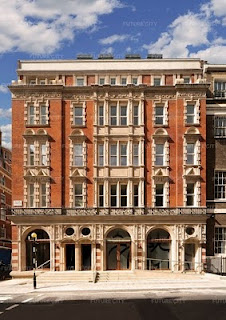
My railings have just been officially unveiled at no1 Grafton Street... nice for a veteran Monopoly player to have at last a stake in Mayfair. There was no mention in the opening speech (by the developer's grand fromage) of Future City who nursed the project from beginning to end or of MDM who actually made the work. I took the opportunity however, in the customary 'few words from the artist', pointedly to make amends. It was a rum affair in a virtual world, entirely attended apart from my own two invitees, Jeremy King and Nick Tite, by men in identical suits. With much relief and thanks to Jeremy, Nick and I quickly repaired to the Wolsely.
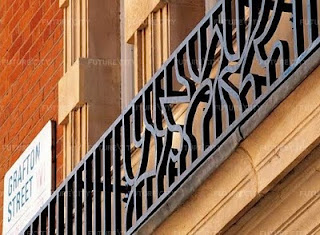
On the way to Grafton St I looked in at Westminster Cathedral to catch a glimpse of the new mosaic of St David recently blessed by the Pope. This occupies a space I had been allotted for my own design of the same subject, once approved but recently rejected through some clerical skullduggery, or Madonna, or Maradonna and the Hand of God. It would have had to be pretty impressive to have broken through my vanity and professional pride to gain approval. There was however no problem in that it is a spangly confection that looks to be largely made of boiled sweets. More interesting perhaps was to notice a small group of conspicuously gay men looking up at my mosaic of Cardinal Newman, himself elected last month to the company of the Blessed and therefore on the fast track to sainthood. Could they have been prospecting for their future patron saint? Might I inadvertently have created a gay ikon? Newman is currently one miracle short of a halo. Might this eventually, and ironically, be it?
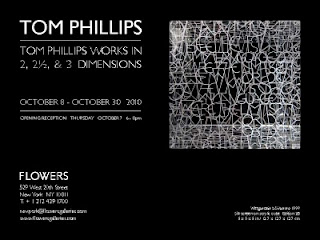
I am currently installed at the Institute for Advanced Study in Princeton and keeping an eye on my imminent exhibition in New York. Any of my East Coast readers, or all three of them, are invited to the opening on the 7th October. Do say hello if you turn up.















